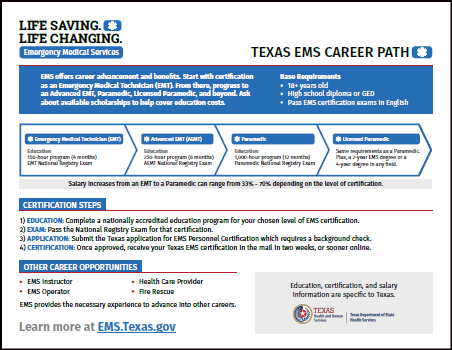- Applications and Forms
- Open Records Requests
- EMS Careers and Education
-
- EMS Education Providers
- Out of Hospital Do Not Resuscitate Program
- Criminal History
- Data Sources for EMS Trauma Systems
- EMS/Trauma Systems Interactive Map
-
- Emergency Care Attendant Training Funding
- EMS Allotment-Allocation Eligibility
- Extraordinary Emergency Fund
-
- FY 2019 Uncompensated Trauma Care Fund Distribution (5111) – August 2021
- FY 2019 Uncompensated Trauma Care Fund Distribution (SB500) – May 2021
- FY 2019 Uncompensated Trauma Care Fund Distribution (Funds 5108 & 5007) – August 2021
- FY 2020 Uncompensated Trauma Care Fund Distribution (5111) – August 2022
- FY 2020 Uncompensated Trauma Care Fund Distribution (Funds 5108 & 5007) – August 2022
- FY 2021 Uncompensated Trauma Care Fund Distribution (Funds 5108 & 5007) – June 2023
- FY 2021 Uncompensated Trauma Care Fund Distribution (5111) - June 2023
- FY 2022 Uncompensated Trauma Care Fund Distribution (Funds 5108 & 5007) – July 2024
- FY 2022 Uncompensated Trauma Care Fund Distribution (5111) – July 2024
-
- GETAC- Air Medical and Specialty Care Transport Committee
- GETAC- Cardiac Care Committee
- GETAC- EMS Education Committee
- GETAC- EMS Medical Directors Committee
- GETAC- Disaster Preparedness and Response Committee
- GETAC- Stroke Committee
- GETAC- Trauma Systems Committee
- GETAC- Injury Prevention and Public Education Committee
- GETAC- Pediatrics Committee
- GETAC- Emergency Medical Services Committee
- GETAC Council
- Texas EMS Trauma Awards
- Texas EMS Line of Duty Deaths
- Texas EMS Trauma News
EMS Careers and Education

Life Saving. Life Changing. Start a career in Emergency Medical Services (EMS).
Videos
Texas EMS – Life Saving. Life Changing Commercial (30 Secs)
What I Love Most About EMS (30 Secs)
EMS Career Path Infographic

Start a career in EMS in only 4 months. Education and certification requirements.
EMS Education
Complete an EMS education program or online training. Use the rosters below to search for DSHS (and nationally) approved programs and courses.
- EMS Course Hours – See course hour requirements
- Excel File: EMS Education Providers
- Excel File: EMS Initial Education Courses
- Excel File: EMS Online Training Courses
EMS Exam
Once your education is complete, pass the National Registry Exam for that level of EMS certification.
- EMS Exam Information – Details and exam requirements
- EMS National Registry Exam – Schedule your exam
In Texas, there are almost 800 EMS agencies, staffing over 72,000 responding professionals, on over 5,000 ambulances.
EMS Certification
Follow the steps in the links below to obtain your certification in Texas.
- EMS Certification Process – Complete details about licensure in Texas
- National Registry of Emergency Medical Technicians – National EMS Certification
- EMS Continuing Education – Courses to renew current EMS certification
- EMS Reciprocity – For out of state applicants and military personnel
EMS Jobs
Emergency Medical Services in Texas are supported by both paid and volunteer personnel. Find available EMS jobs and volunteer opportunities. Use the Texas Workforce Commission website or contact EMS providers in your area.
- WorkInTexas.com – Workforce Commission job search
- Type your level of licensure into the keyword field (EMT, AEMT, Paramedic)
- EMS Providers (Excel File) – DSHS Licensed EMS Providers in Texas
In EMS, you can work full-time, part-time, or volunteer to support your community’s emergency health care needs. It's a career in high demand where you can grow your knowledge and expand your personal worth in a fast-paced setting.
Top Reasons People Work in EMS:
- Great way to serve people and your community.
- Camaraderie and sense of family within the EMS system.
- Competitive salaries and benefits.
- Provides the necessary experience to advance into other careers.
EMS Career Advantages:
- Become certified and start work in as little as 4 months.
- Stable job security because there is always a need in our communities.
- Advancement from an EMT to a Licensed Paramedic.
- Average EMS salary in Texas is $60,000 annually, and continues to increase.
Hear first-hand from Texas EMS personnel. Explore their careers, how they got started, and what it’s like in EMS.
Adam, Licensed Flight Paramedic
Adam describes working as a flight paramedic and ways to get involved to start an EMS career.
Aubrey, Paramedic
Aubrey shares how it’s empowering to serve in EMS and opportunities to give back to the community.
Darcy, Emergency Medical Technician
Darcy talks about starting in EMS in high school and resources available to practicing personnel.
Mike, Emergency Medical Technician
Mike explores EMS career path options and flexibility within the work schedule.
Gilberto, Flight Paramedic
Gilberto discusses moving from military service into EMS and continuing to serve the community.
Gilberto, Flight Paramedic (ES)
Gilberto habla sobre su transición del servicio militar a servicios médicos de emergencia (EMS) y cómo esta carrera le permite seguir sirviendo a la comunidad.
Maddy, Paramedic
Maddy describes what it’s like on-shift, in the station, and why EMS jobs are so rewarding.
Darienn, Paramedic
Darienn shares the value of a quality EMS education and making connections in the community.
Media Kit
News outlets are encouraged to report on the state’s efforts to encourage Texans to join the EMS profession. The DSHS media kit includes EMS photos and quotes as well as testimonial videos and b-roll footage for download.